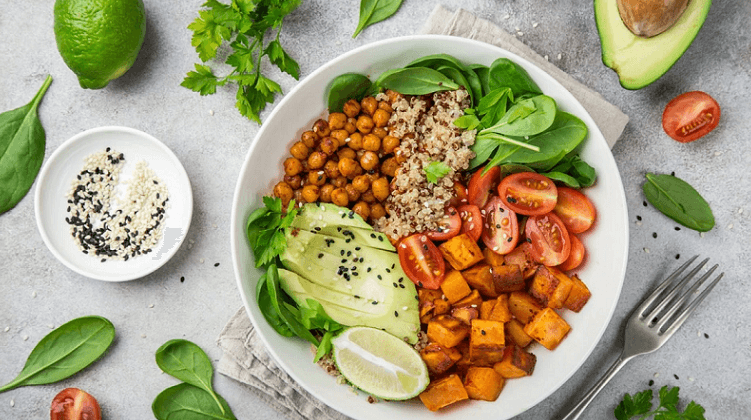How Do Vegan Bodybuilders Get Their Protein?
When it comes to bodybuilding and growing muscle, the importance of protein cannot be overstated.
Protein is one of three macronutrients (the others being fats and carbohydrates) that provide the body with calories (energy). The main function of protein is to build, strengthen and repair things. It plays a key role in repairing music tissue after it is broken down during exercise.
What is Protein
If we examine protein at a chemical level, we discover that it is composed long chains of amino acids. These are organic compounds that are made of carbon, oxygen, hydrogen, nitrogen or sulfur.
There are several different types of amino acids. Structurally they are somewhat similar. Each amino acid has one hydrogen atom and one carboxylic acid, and an amino group. What makes them unique are their variable components, called side chains.
A side chain is a unique chemical group that determines which bonds can be formed. This is critical because a side chain can hold a length of protein to a specific shape, which stabilizes their structure and effects energy output.

Essential Amino Acids
An essential amino acid is one that cannot be synthesized by the human body. These must be consumed in the form of food.
Out of the 20 essential amino acids to go into making protein, there are a total of 9 that humans are unable to synthesize naturally. These are:
- Isoleucine
- Histidine
- Lysine
- Leucine
- Methionine
- Phenylalanine
- Threonine
- Typtophan
- Valine
The Difference Between Animal and Plant Protein
The foods that contain these amino acids in equal amounts are called ‘complete proteins’. And complete proteins are found in mainly animal sources such as meat, eggs and milk.
It is commonly claimed that a vegan diet can not contain complete proteins. This is only true if we take one food source in isolation. It’s true that plant proteins are somewhat different as each plant has a different amino acid profile.
Structurally, plant and animal protein are not that different. What varies, is the ratio of amino acids.
As an example, cereal and grains and known to be low in lysine. If someone only consumes cereal and grains, they simply would not be consuming enough lysine. This can be overcome by complimenting it with a food that is high in lysine, such as peanuts or lentils.
It is not necessary to eat these complementary proteins at every meal. A more effective strategy is to get a variety of proteins throughout the day to ensure you get a full complement of amino acids.
Here now, are a list of foods and the amino acid proteins they contain:
#1. Isoleucine
Food source: Almonds, avocados, cashews, chickpeas, coconut, lentils, olives, papaya, seaweed and seeds such as sunflower.
#2. Histidine
Food source: Apples, bananas, beans, beets, buckwheat, carrots, cantaloupe, cauliflower, celery, citrus fruits, cucumber, dandelion, endive, garlic, greens, legumes, mushrooms, pomegranates, radish, rice, seaweed, sesame, spinach, spirulina and turnip greens.
#3. Lysine
Food source: Amaranth, apples, apricots, beans, beets, carrots, celery, cucumber, dandelion, greens, grapes, papaya, parsley, pears, peas, spinach and turnip greens.
#4. Leucine
Food source: Almonds, asparagus, avocados, chickpeas, coconut, lentils, oats, olives, papaya, rice, sunflower seeds and walnuts.
#5. Methionine
Food source: Black beans, brazil nuts, cashews, kidney beans, oats, sesame seeds, spirulina, spinach, sunflower seeds and watercress.
#6. Phenylalanine
Food source: Apples, beets, carrots, cashews, flax seed, hazelnuts, nutritional yeast, parsley, pineapples, pumpkin seeds, sesame seeds, sunflower seeds, spinach and tomatoes.
#7. Threonine
Food source: Almonds, beans, carrots, celery, chickpeas, collards, flax seeds, greens, green leafy vegetables, kale, lentils, lima beans, nori, nuts, papaya, sesame seeds, sunflower seeds and walnuts.
Food source: Brussels sprouts, carrots, celery, chives, dandelion greens, endive, fennel, nutritional yeast, pumpkin seeds, sesame seeds, snap beans, spinach, sunflower seeds, turnips and walnuts.
#8. Valine
Food source: Apples, almonds, bananas, beets, broccoli, carrots, celery, dandelion greens, lettuce, nutritional yeast, okra, parsley, parsnips, pomegranates, potatoes, squash, tomatoes and turnips.

Can Vegans Use Protein Powder?
It is common for bodybuilders and athletes to use a protein powder to ensure they hit their daily protein goal, without consuming too many calories. The most effective, and commonly used protein powder is whey protein.
Whey protein obtained from cow’s milk and is therefore a dairy product. This means that followers of vegan diets will choose not to use it. There are a number vegan friendly alternatives on the market, and these can be added to a fruit smoothie or sprinkled on top of a meal.
The key to choosing a vegan protein powder is to scrutinize the ingredients and select one that is composed of a variety of protein sources.
How To Tell If You’re Getting Enough Protein
The recommended daily allowance of protein for sedentary people is 0.36g per pound of bodyweight. For athletes the general recommendation is 1g per pound of bodyweight. People cycling steroids or on heavy bulking diets often choose to consume more.
If you are not balancing your amino acid types correctly you may however experience the symptoms of protein deficiency. There are a number of warning signs to watch out for.
Not Seeing Noticeable Gains
If you are not taking in an adequate amount of protein you will find you are just spinning your wheels in the gym with little to show for it. The reason is because when your body is lacking protein, it will break down muscle fiber to get what it needs instead.
Lack of Energy and Focus
Your body will utilize protein for energy. Protein also dictates how well your body absorbs nutrients from food. When your muscles don’t have adequate fuel, you will fatigue rapidly. This also effects brain functions like the ability to concentrate. Foggy thinking is a sign you need to up your daily protein intake.
Skin, Hair and Nail Problems
Your skin, hair and nails are made of protein therefore a protein deficiency will often show up in these areas. Hair may thin and lose color. Nails may become brittle and break easily. Skin may become flaky or depigmented.
Increased Severity of Infections
One serious side effect of protein deficiency is on the immune system. An inadequate immune response, or getting sick easily and often is a warning sign that you cannot ignore.
How To Treat Protein Deficiency
It’s important to realize that the symptoms listed above may be signs of other health conditions such as anemia or iron-deficiency. The first step in identifying the problem is to consult with your doctor, who can perform a blood test to check if your protein is low or out of balance.
After the correct condition is labelled, the cause can be identified and a suitable treatment plan can be put in place. Treatment will vary depending on the patients’ health, diet and medical history. Most of the time, this can be fixed through altering the diet, however your doctor may choose to monitor your progress to ensure there is no damage to, or disorder of the kidneys or liver.

Take Home Message
It is important for both health and physical improvement to ensure you get enough protein throughout the day. And as you can see, following a vegan diet does not mean you are at risk of protein deficiency any more than anyone else.
Variety is the key to ensuring an adequate intake of all the essential amino acids that a person needs and plant-based diets can easily provide that.


